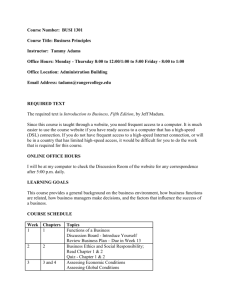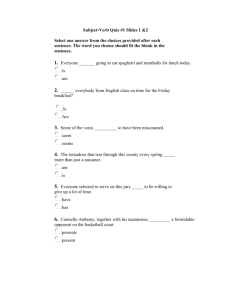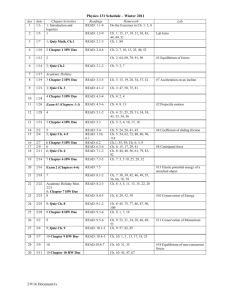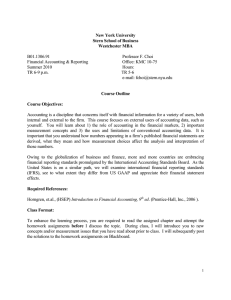C10.0001.02 - New York University
advertisement
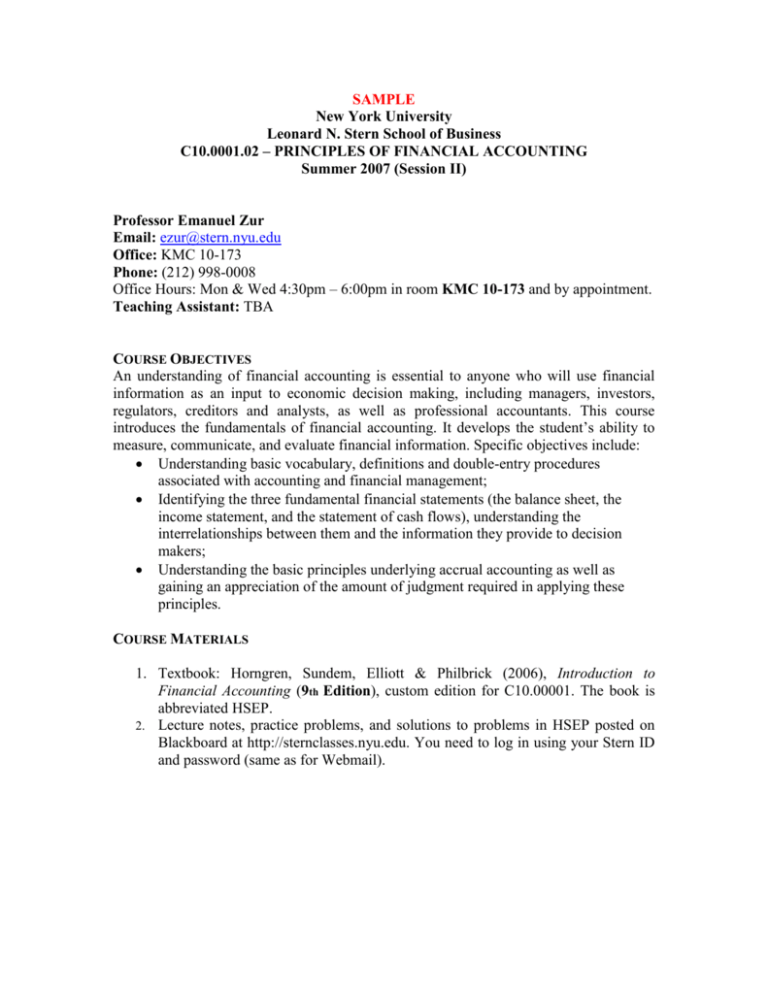
SAMPLE New York University Leonard N. Stern School of Business C10.0001.02 – PRINCIPLES OF FINANCIAL ACCOUNTING Summer 2007 (Session II) Professor Emanuel Zur Email: ezur@stern.nyu.edu Office: KMC 10-173 Phone: (212) 998-0008 Office Hours: Mon & Wed 4:30pm – 6:00pm in room KMC 10-173 and by appointment. Teaching Assistant: TBA COURSE OBJECTIVES An understanding of financial accounting is essential to anyone who will use financial information as an input to economic decision making, including managers, investors, regulators, creditors and analysts, as well as professional accountants. This course introduces the fundamentals of financial accounting. It develops the student’s ability to measure, communicate, and evaluate financial information. Specific objectives include: Understanding basic vocabulary, definitions and double-entry procedures associated with accounting and financial management; Identifying the three fundamental financial statements (the balance sheet, the income statement, and the statement of cash flows), understanding the interrelationships between them and the information they provide to decision makers; Understanding the basic principles underlying accrual accounting as well as gaining an appreciation of the amount of judgment required in applying these principles. COURSE MATERIALS 1. Textbook: Horngren, Sundem, Elliott & Philbrick (2006), Introduction to Financial Accounting (9th Edition), custom edition for C10.00001. The book is abbreviated HSEP. 2. Lecture notes, practice problems, and solutions to problems in HSEP posted on Blackboard at http://sternclasses.nyu.edu. You need to log in using your Stern ID and password (same as for Webmail). COURSE FORMAT A combination of lectures, class discussions, and reviews of assigned homework problems will be used. Assigned readings and homework problems listed on the syllabus should be completed before coming to class. On a few occasions, assignments will be collected at the beginning of class and graded 0, 1 or 2 based on effort in attempting to solve the problems. Solutions to all problems from the assigned chapter(s) will be posted on Blackboard at http://sternclasses.nyu.edu after each class. Attendance and class participation is strongly recommended and will be part of the final grade for this course. As new material always builds on prior concepts in accounting, the importance of keeping up with the coursework cannot be overemphasized. You should make good use of help from the TA and/or the professor if you have any question regarding the course material, problems, exams, etc. GRADING Final grades will be computed as follows: Class Attendance / Participation / Homework - 15% Small Quizes – 20% Quiz - 15% Final Exam - 50% Exam Policy: The quiz and the exam are closed book and closed notes. Use of laptops will not be allowed. However, you are allowed to bring one 8.5 x 11" sheet of notes to each quiz /exam (you may use both sides). You should bring a calculator to the quiz and exams. The format of the quiz and exam will be discussed in class. The final exam will be cumulative, as accounting is necessarily cumulative, with an emphasis on material covered since the previous quiz / exam. We will have few small quizzes in the beginning of classes. You are expected to take all quiz and exams at the scheduled times. Make-ups for any quiz or exam will only be allowed if you have a University-approved excuse (e.g., severe illness or family emergency) and if you notify the professor prior to the date and time of the quiz / exam. Failure to do so or lack of a valid reason for your absence will result in a score of 0 for the missed quiz / exam. Date Topics & Assigned Readings 6/25 Course Introduction Chapter 1: Balance Sheet Chapter 2: Income Statement Chapter 2: Income Statement (cont’d) Chapter 3: Recording Transactions 6/27 Assigned Problems 1-36, 1-40 2-34, 2-45 2-55 3-20, 3-40 7/2 7/4 7/9 7/11 7/16 7/18 7/23 7/25 7/30 8/1 Chapter 4: Accrual Accounting Review: Chapters 1-4 No Class QUIZ: Chapters 1-4 (emphasis on chapters 3 & 4) Chapter 6: Sales & AR (read p.232250, skim the rest) Chapter 7: COGS & Inventory (read p.280-300 & p.303-307, skim the rest) Chapter 8: Long-Lived Assets & Depreciation (read p.336-346, skim the rest) Chapter 9: Current Liabilities (read p.384-389) Chapter 9 : Time-Value of Money (p.418-424) Chapter 9: Long-Term Liabilities & Bond Accounting (read p.390-404) Chapter 10: Stockholders’ Equity Chapter 5: Statement of Cash Flows (read p.185-204, skim the rest) Review: All chapters (emphasis on chapters 9 & 5) & Sample Final Exam FINAL EXAM: Chapters 1-9 (emphasis on chapters 9 & 5) 3-39, 3-45 4-35, 4-43 6-41, 6-48, 6-49 Chap.6 HW Handout 7-41, 7-47, 7-51, 7-75 8-37, 8-42, 8-51 Sample Midterm Exam* 9-33, 9-41 9-50* 9-52, 9-56, 9-58 Chap.5 HW Handout Sample Final Exam*


